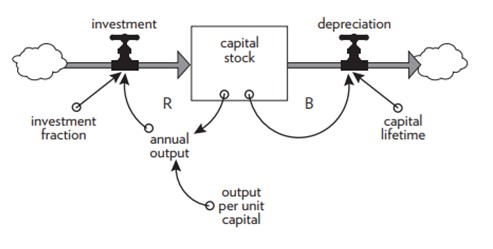We Need To Think Better: The Immense Power Of Systems Thinking

Discover how systems thinking offers a powerful lens to understand complexity, uncover hidden patterns, and create lasting change
Years ago, as a teen, I came across a concept that radically changed my perspective and outlook on everything I did. Growing up, I had a burning curiosity to understand how and why things worked, and in my geography lessons, I would constantly be confused as to how clouds were formed and dissipated; I could find a plethora of reasons as to why the simple linear explanations my teachers taught me would not always apply in specific scenarios.
One thing that could arguably increase climate change, such as increased GHGs, should also have the potential to decrease climate change by reflecting the sun’s light. Am I right? No, unfortunately, I was wrong, but maybe some truth existed in these trains of thought.
The simple, linear explanations used to explain away scientific phenomena often indicate a more complicated process. The underlying climate, ecosystems, and biodiversity mechanisms were more complex than a simple cause-and-effect relationship. This phenomenon of complexity extends way beyond our environment, encompassing our economies, businesses, and even politics. Reading Meadows ‘Thinking in Systems’ opened my mind to the world's complexity and how to (initially) deal with it.
A systems approach is both philosophical and practical. With this mental model, systems thinking provides a comprehensive framework for understanding the intricate relationships and interdependencies that shape our reality. By taking a holistic approach, we can navigate complex challenges, uncover hidden insights, and create more effective solutions.
Why Think in Systems?
Systems thinking offers a paradigm shift from reductionist thinking, which focuses on isolated parts, to a broader perspective considering the whole and its parts in context. Here are three compelling reasons to embrace systems thinking:
- Grasping Complexity: Systems thinking enables us to comprehend the complexity of interconnected issues and phenomena. It allows us to see beyond linear cause-and-effect relationships and uncover the intricate web of feedback loops, delays, and interdependencies within a system. This holistic perspective helps us understand how diverse elements interact to create systemic behaviour, illuminating the underlying dynamics of complex problems.
- Uncovering Hidden Patterns: By examining the interconnections within a system, we can identify patterns, trends, and underlying structures that influence outcomes. Systems thinking helps us move beyond superficial analysis and uncover the root causes of problems. By identifying leverage points within the system, we can make interventions that have a more significant and lasting impact.
- Anticipating Unintended Consequences: Systems thinking prompts us to consider the long-term implications of our actions. It helps us recognise that changes in one part of a system can have ripple effects throughout, often leading to unintended consequences. By embracing systems thinking, we develop a heightened awareness of the interconnectedness of our actions and can make more informed decisions that consider the broader context and potential systemic impacts.
How to Think in Systems:
Adopting a systems thinking mindset requires a deliberate shift in our approach to problem-solving. Systems are a series of interconnected elements and flows that work together to achieve a specific purpose.
- Recognise the System: Identify the system's boundaries you are examining and understand its components, relationships, and interactions. Consider the visible elements, underlying structures, and feedback loops that influence the system's behaviour.
- Emphasise Feedback Loops: Explore the feedback loops within the system, which can be reinforcing (positive feedback) or balancing (negative feedback). Understand how these loops shape the system's dynamics and lead to self-reinforcing or self-regulating behaviours.
- Identify Stocks and Flows: Recognize the stocks (accumulated quantities) and flows (rates of change) within the system. Understand how inflows and outflows affect the stocks and how stock changes can impact the overall system behaviour.
- Analyse Cause and Effect Relationships: Go beyond linear cause-and-effect thinking and consider the circular causality and delayed effects characteristic of systems. Recognize that actions taken in one part of the system can have unintended consequences in other parts.
- Consider Time Delays: Recognize that the effects of actions or interventions in a system may take time to establish. Be aware of time delays, feedback delays, and the time required for changes to propagate throughout the system.
- Identify Leverage Points: The key points within the system where small interventions can lead to significant changes. These leverage points can be structural, such as changing system goals or feedback loops, or they can involve mindset shifts and addressing underlying assumptions.
- Embrace Complexity and Uncertainty: Systems thinking acknowledges the inherent complexity and uncertainty of real-world systems. Embrace the interconnections, multiple perspectives, and non-linearity characteristic of complex systems.
- Continuously Learn and Adapt: Systems thinking is an ongoing learning, feedback, and adaptation process. Regularly reassess and update your mental models as new information becomes available and the system evolves.

Figure 1 - Economic Capital System: Look at the different flows, stocks, and feedback loops. How do you think this simple system operates? What other concepts could this system be applied to, from a country’s population to the temperature of a mug of coffee? (Meadows, 2008)
Applying Systems Thinking:
Once you have developed a systems thinking mindset, you can apply it to various domains. Here are a few examples:
- Organisational Management: Apply systems thinking to optimise organisational processes, identify bottlenecks, and improve team collaboration. Consider the impact of changes in one department on the overall organisation. Understand how individual roles and team dynamics influence the organisation as a whole.
- Environmental Sustainability: Analyze the interconnections between human activity, ecosystems, and climate change. Apply systems thinking to identify leverage points for mitigating environmental impact and promoting sustainable practices. Consider how changes in consumption patterns, energy sources, and waste management systems can lead to positive feedback loops that support ecological sustainability.
- Public Policy: Apply systems thinking to design effective policies that address complex societal issues, such as poverty, education, or healthcare. Consider the systemic factors influencing these issues and design interventions that take into account the broader context. Understand how policies in one area can have ripple effects throughout the system, affecting other interconnected areas.
- Your Human Life: Understanding how you live and operate, how exercise affects your physical and mental state, how your mental states affect your physical states, why what you eat matters, and how you eat affects your overall health. Adopting this system perspective allows for a greater understanding of the complexity of ourselves.
Conclusion:
Embracing systems thinking is a powerful tool for navigating complexity in our interconnected world. By shifting our mindset, adopting a holistic perspective, and applying systems thinking principles, we can gain a deeper understanding of complex issues, uncover hidden insights, and develop more effective and sustainable solutions. Systems thinking empowers us to address challenges with a broader perspective, enabling us to create positive systemic change and confidently navigate the complexities of our world.
However, it is imperative to remember that systems thinking is not a panacea for complex challenges. Instead, it is a tool, like a screwdriver, with many uses. Specific issues will benefit from thinking in systems, whereas others require simple cause-and-effect models. Adding the systems thinking toolkit to your repertoire, though, only serves to increase your problem-solving capacity.
After reading Meadows, I began to appreciate the environment around me significantly, from family relationships and political connections to the nature of flora and fauna in our garden, all the way to a deeper understanding of my university studies. With any work I do, I can focus on the critical leverage points and determine what matters to produce more significant outcomes. The world will be a better place when we all realise that nothing we do exists within a vacuum. We are all connected.
What do you think?
References
Meadows, D.H., 2008. Thinking in systems: A primer. Chelsea Green Publishing.
 Meryl Sukumar
Meryl Sukumar 